Comprehensive Management Report: DEF Financial Advisory Firm Expansion
VerifiedAdded on 2021/06/17
|18
|3895
|49
Report
AI Summary
This report provides a detailed management overview of DEF, a financial advisory firm based in Australia, focusing on its expansion plans for a new division. The report analyzes the firm's strategies for planning, organizing, leading, and controlling a virtual team to deliver innovative financial services. It includes an environmental scan, explores different team structures (virtual, global, and self-managed), and recommends the most suitable approach for DEF. The report also provides recommendations on leadership styles, reward systems, communication strategies, and the design and structure of the virtual team, emphasizing specialization, centralization, and formalization. Furthermore, it highlights the importance of transformational leadership for motivating team members and achieving high performance. Overall, the report offers a comprehensive analysis of DEF's management practices and provides actionable insights for the successful implementation of its expansion plans.

Running head: MANAGEMENT
Management
Name of the Student:
Name of the University:
Author Note:
Management
Name of the Student:
Name of the University:
Author Note:
Paraphrase This Document
Need a fresh take? Get an instant paraphrase of this document with our AI Paraphraser
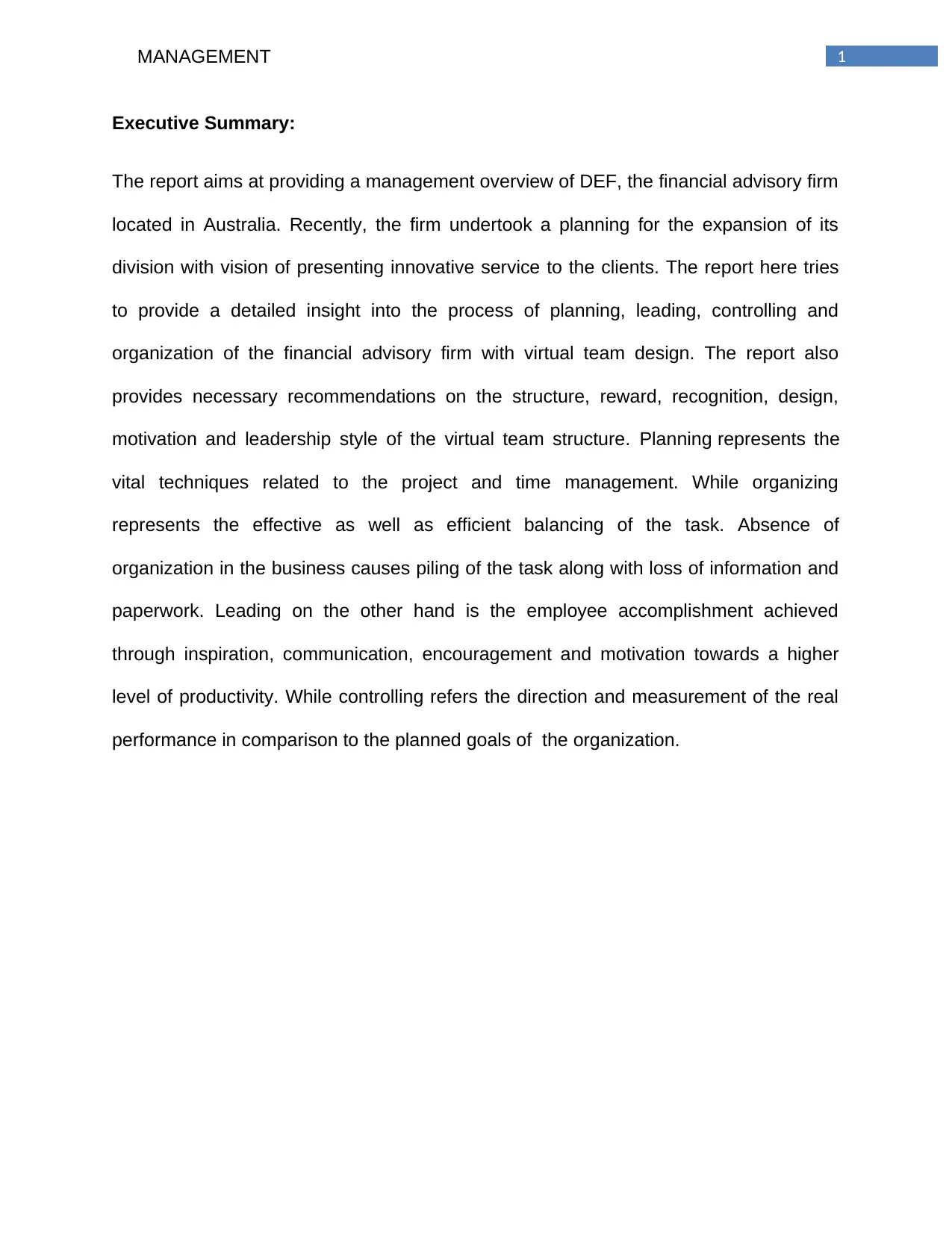
1MANAGEMENT
Executive Summary:
The report aims at providing a management overview of DEF, the financial advisory firm
located in Australia. Recently, the firm undertook a planning for the expansion of its
division with vision of presenting innovative service to the clients. The report here tries
to provide a detailed insight into the process of planning, leading, controlling and
organization of the financial advisory firm with virtual team design. The report also
provides necessary recommendations on the structure, reward, recognition, design,
motivation and leadership style of the virtual team structure. Planning represents the
vital techniques related to the project and time management. While organizing
represents the effective as well as efficient balancing of the task. Absence of
organization in the business causes piling of the task along with loss of information and
paperwork. Leading on the other hand is the employee accomplishment achieved
through inspiration, communication, encouragement and motivation towards a higher
level of productivity. While controlling refers the direction and measurement of the real
performance in comparison to the planned goals of the organization.
Executive Summary:
The report aims at providing a management overview of DEF, the financial advisory firm
located in Australia. Recently, the firm undertook a planning for the expansion of its
division with vision of presenting innovative service to the clients. The report here tries
to provide a detailed insight into the process of planning, leading, controlling and
organization of the financial advisory firm with virtual team design. The report also
provides necessary recommendations on the structure, reward, recognition, design,
motivation and leadership style of the virtual team structure. Planning represents the
vital techniques related to the project and time management. While organizing
represents the effective as well as efficient balancing of the task. Absence of
organization in the business causes piling of the task along with loss of information and
paperwork. Leading on the other hand is the employee accomplishment achieved
through inspiration, communication, encouragement and motivation towards a higher
level of productivity. While controlling refers the direction and measurement of the real
performance in comparison to the planned goals of the organization.
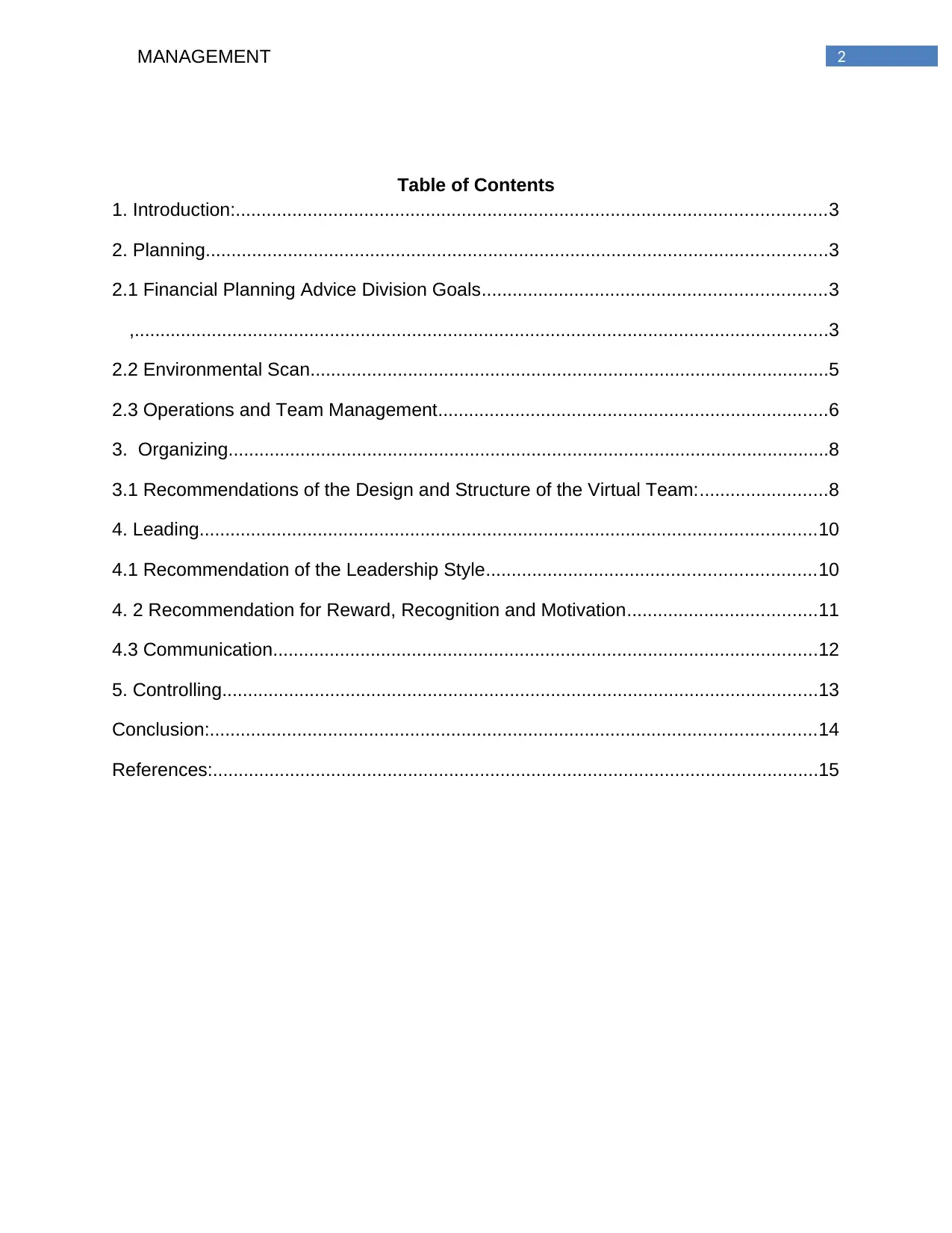
2MANAGEMENT
Table of Contents
1. Introduction:...................................................................................................................3
2. Planning.........................................................................................................................3
2.1 Financial Planning Advice Division Goals...................................................................3
,.......................................................................................................................................3
2.2 Environmental Scan.....................................................................................................5
2.3 Operations and Team Management............................................................................6
3. Organizing.....................................................................................................................8
3.1 Recommendations of the Design and Structure of the Virtual Team:.........................8
4. Leading........................................................................................................................10
4.1 Recommendation of the Leadership Style................................................................10
4. 2 Recommendation for Reward, Recognition and Motivation.....................................11
4.3 Communication..........................................................................................................12
5. Controlling....................................................................................................................13
Conclusion:......................................................................................................................14
References:......................................................................................................................15
Table of Contents
1. Introduction:...................................................................................................................3
2. Planning.........................................................................................................................3
2.1 Financial Planning Advice Division Goals...................................................................3
,.......................................................................................................................................3
2.2 Environmental Scan.....................................................................................................5
2.3 Operations and Team Management............................................................................6
3. Organizing.....................................................................................................................8
3.1 Recommendations of the Design and Structure of the Virtual Team:.........................8
4. Leading........................................................................................................................10
4.1 Recommendation of the Leadership Style................................................................10
4. 2 Recommendation for Reward, Recognition and Motivation.....................................11
4.3 Communication..........................................................................................................12
5. Controlling....................................................................................................................13
Conclusion:......................................................................................................................14
References:......................................................................................................................15
⊘ This is a preview!⊘
Do you want full access?
Subscribe today to unlock all pages.

Trusted by 1+ million students worldwide

3MANAGEMENT
1. Introduction:
The report provides an insight into management aspect of a Financial Advisory
Firm based in Australia. The firm under discussion is DEF, which is one of the largest
advisory firms based in Australia with over 300 staffs and offices located along the
Australian east coast. DEF also represents a network of the partner firms across the
country. The firm is also responsible for providing planning, retirement and financial
seminars along with advice of the specialist in superannuation, retirement, divorce,
corporate and aged care. The strategy of DEF is based on the growth and quality due to
their strong reputation in the industry. The firm holds the vision of enriching the client’s
life by overpowering them in making important decisions of life depending on the
financial advice provided by dedicated expert team. The firm however plans in setting
up a newer division located at an arm’s length distance from the main branch. This was
done for providing innovative service to the clients referred to them from other
organizations related to debt recovery. For carrying out this activity, the firm plans to
provide phone line advice to the clients through the expertise financial planners from 7
am to 10 pm from Monday to Sunday. The report helps in analyzing the decision of the
firm in setting of the newer division through planning, organizing, leading and
controlling. The DEF’s new division has however considered three options for operating
its advice line that includes virtual team, global overseas team and self-managed team.
The report in analyzing the three options and suggest the options that best suits DEF.
2. Planning
2.1 Financial Planning Advice Division Goals
Operational
Aspects
Human Resource
Aspects
Financial Aspects
1. Introduction:
The report provides an insight into management aspect of a Financial Advisory
Firm based in Australia. The firm under discussion is DEF, which is one of the largest
advisory firms based in Australia with over 300 staffs and offices located along the
Australian east coast. DEF also represents a network of the partner firms across the
country. The firm is also responsible for providing planning, retirement and financial
seminars along with advice of the specialist in superannuation, retirement, divorce,
corporate and aged care. The strategy of DEF is based on the growth and quality due to
their strong reputation in the industry. The firm holds the vision of enriching the client’s
life by overpowering them in making important decisions of life depending on the
financial advice provided by dedicated expert team. The firm however plans in setting
up a newer division located at an arm’s length distance from the main branch. This was
done for providing innovative service to the clients referred to them from other
organizations related to debt recovery. For carrying out this activity, the firm plans to
provide phone line advice to the clients through the expertise financial planners from 7
am to 10 pm from Monday to Sunday. The report helps in analyzing the decision of the
firm in setting of the newer division through planning, organizing, leading and
controlling. The DEF’s new division has however considered three options for operating
its advice line that includes virtual team, global overseas team and self-managed team.
The report in analyzing the three options and suggest the options that best suits DEF.
2. Planning
2.1 Financial Planning Advice Division Goals
Operational
Aspects
Human Resource
Aspects
Financial Aspects
Paraphrase This Document
Need a fresh take? Get an instant paraphrase of this document with our AI Paraphraser
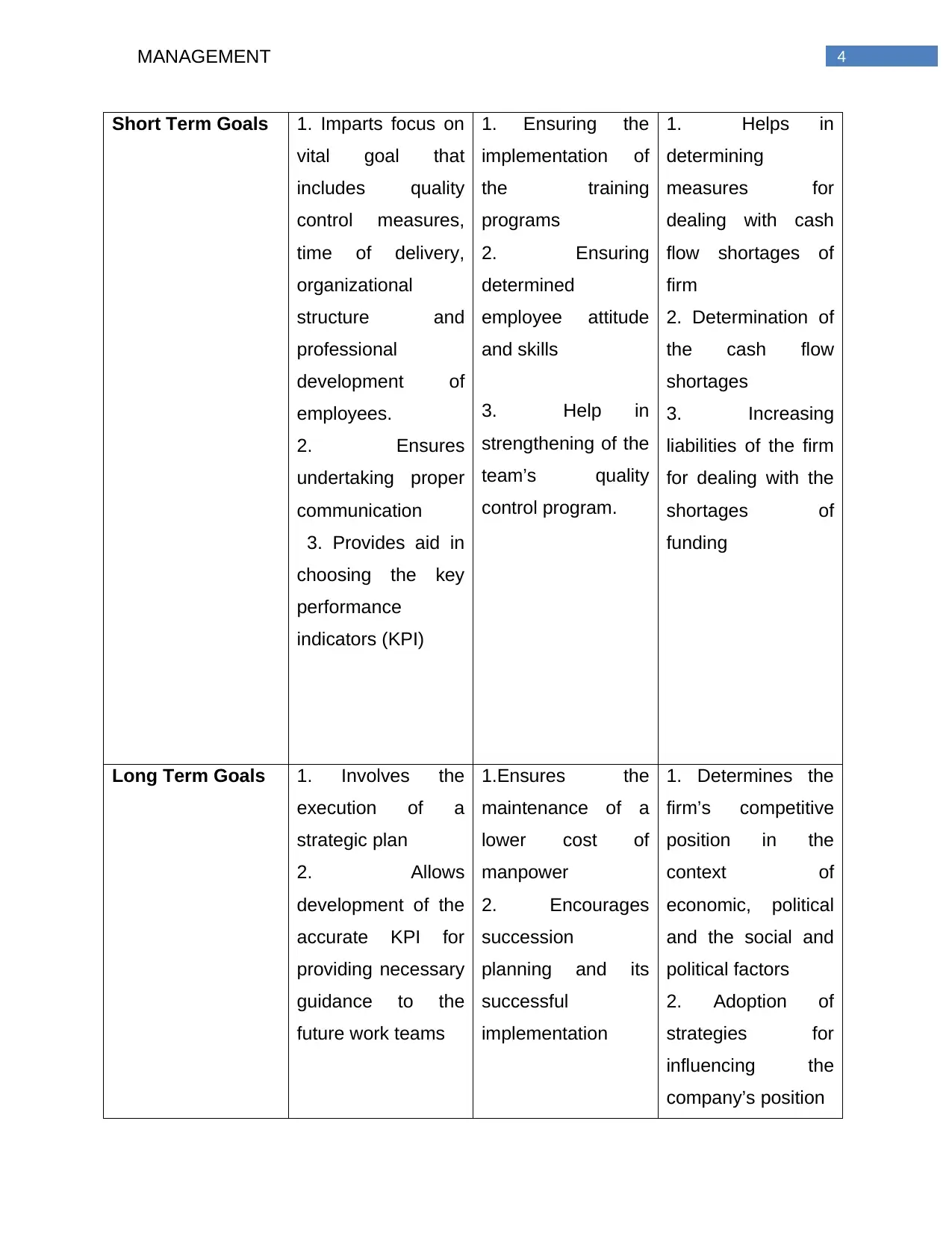
4MANAGEMENT
Short Term Goals 1. Imparts focus on
vital goal that
includes quality
control measures,
time of delivery,
organizational
structure and
professional
development of
employees.
2. Ensures
undertaking proper
communication
3. Provides aid in
choosing the key
performance
indicators (KPI)
1. Ensuring the
implementation of
the training
programs
2. Ensuring
determined
employee attitude
and skills
3. Help in
strengthening of the
team’s quality
control program.
1. Helps in
determining
measures for
dealing with cash
flow shortages of
firm
2. Determination of
the cash flow
shortages
3. Increasing
liabilities of the firm
for dealing with the
shortages of
funding
Long Term Goals 1. Involves the
execution of a
strategic plan
2. Allows
development of the
accurate KPI for
providing necessary
guidance to the
future work teams
1.Ensures the
maintenance of a
lower cost of
manpower
2. Encourages
succession
planning and its
successful
implementation
1. Determines the
firm’s competitive
position in the
context of
economic, political
and the social and
political factors
2. Adoption of
strategies for
influencing the
company’s position
Short Term Goals 1. Imparts focus on
vital goal that
includes quality
control measures,
time of delivery,
organizational
structure and
professional
development of
employees.
2. Ensures
undertaking proper
communication
3. Provides aid in
choosing the key
performance
indicators (KPI)
1. Ensuring the
implementation of
the training
programs
2. Ensuring
determined
employee attitude
and skills
3. Help in
strengthening of the
team’s quality
control program.
1. Helps in
determining
measures for
dealing with cash
flow shortages of
firm
2. Determination of
the cash flow
shortages
3. Increasing
liabilities of the firm
for dealing with the
shortages of
funding
Long Term Goals 1. Involves the
execution of a
strategic plan
2. Allows
development of the
accurate KPI for
providing necessary
guidance to the
future work teams
1.Ensures the
maintenance of a
lower cost of
manpower
2. Encourages
succession
planning and its
successful
implementation
1. Determines the
firm’s competitive
position in the
context of
economic, political
and the social and
political factors
2. Adoption of
strategies for
influencing the
company’s position
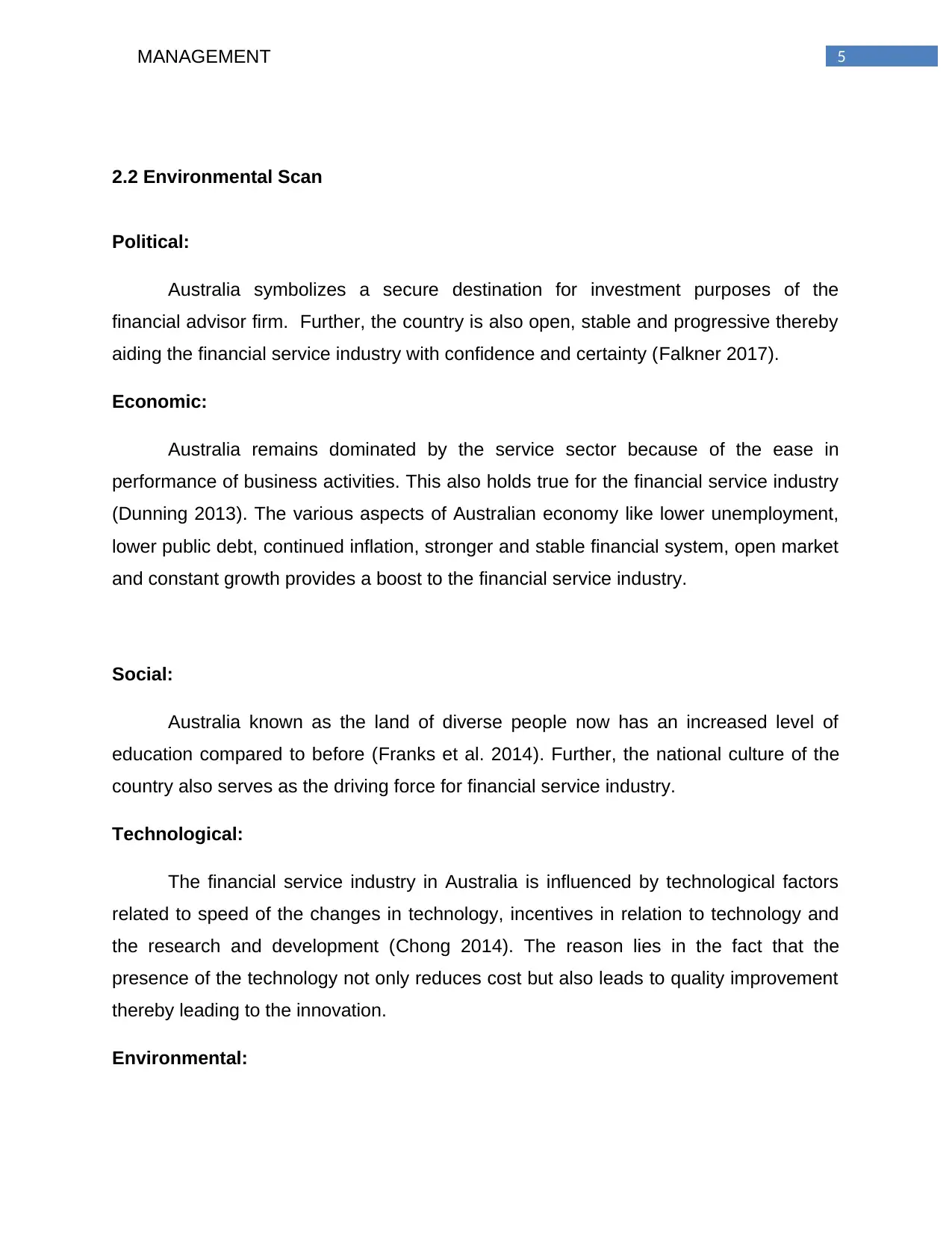
5MANAGEMENT
2.2 Environmental Scan
Political:
Australia symbolizes a secure destination for investment purposes of the
financial advisor firm. Further, the country is also open, stable and progressive thereby
aiding the financial service industry with confidence and certainty (Falkner 2017).
Economic:
Australia remains dominated by the service sector because of the ease in
performance of business activities. This also holds true for the financial service industry
(Dunning 2013). The various aspects of Australian economy like lower unemployment,
lower public debt, continued inflation, stronger and stable financial system, open market
and constant growth provides a boost to the financial service industry.
Social:
Australia known as the land of diverse people now has an increased level of
education compared to before (Franks et al. 2014). Further, the national culture of the
country also serves as the driving force for financial service industry.
Technological:
The financial service industry in Australia is influenced by technological factors
related to speed of the changes in technology, incentives in relation to technology and
the research and development (Chong 2014). The reason lies in the fact that the
presence of the technology not only reduces cost but also leads to quality improvement
thereby leading to the innovation.
Environmental:
2.2 Environmental Scan
Political:
Australia symbolizes a secure destination for investment purposes of the
financial advisor firm. Further, the country is also open, stable and progressive thereby
aiding the financial service industry with confidence and certainty (Falkner 2017).
Economic:
Australia remains dominated by the service sector because of the ease in
performance of business activities. This also holds true for the financial service industry
(Dunning 2013). The various aspects of Australian economy like lower unemployment,
lower public debt, continued inflation, stronger and stable financial system, open market
and constant growth provides a boost to the financial service industry.
Social:
Australia known as the land of diverse people now has an increased level of
education compared to before (Franks et al. 2014). Further, the national culture of the
country also serves as the driving force for financial service industry.
Technological:
The financial service industry in Australia is influenced by technological factors
related to speed of the changes in technology, incentives in relation to technology and
the research and development (Chong 2014). The reason lies in the fact that the
presence of the technology not only reduces cost but also leads to quality improvement
thereby leading to the innovation.
Environmental:
⊘ This is a preview!⊘
Do you want full access?
Subscribe today to unlock all pages.

Trusted by 1+ million students worldwide
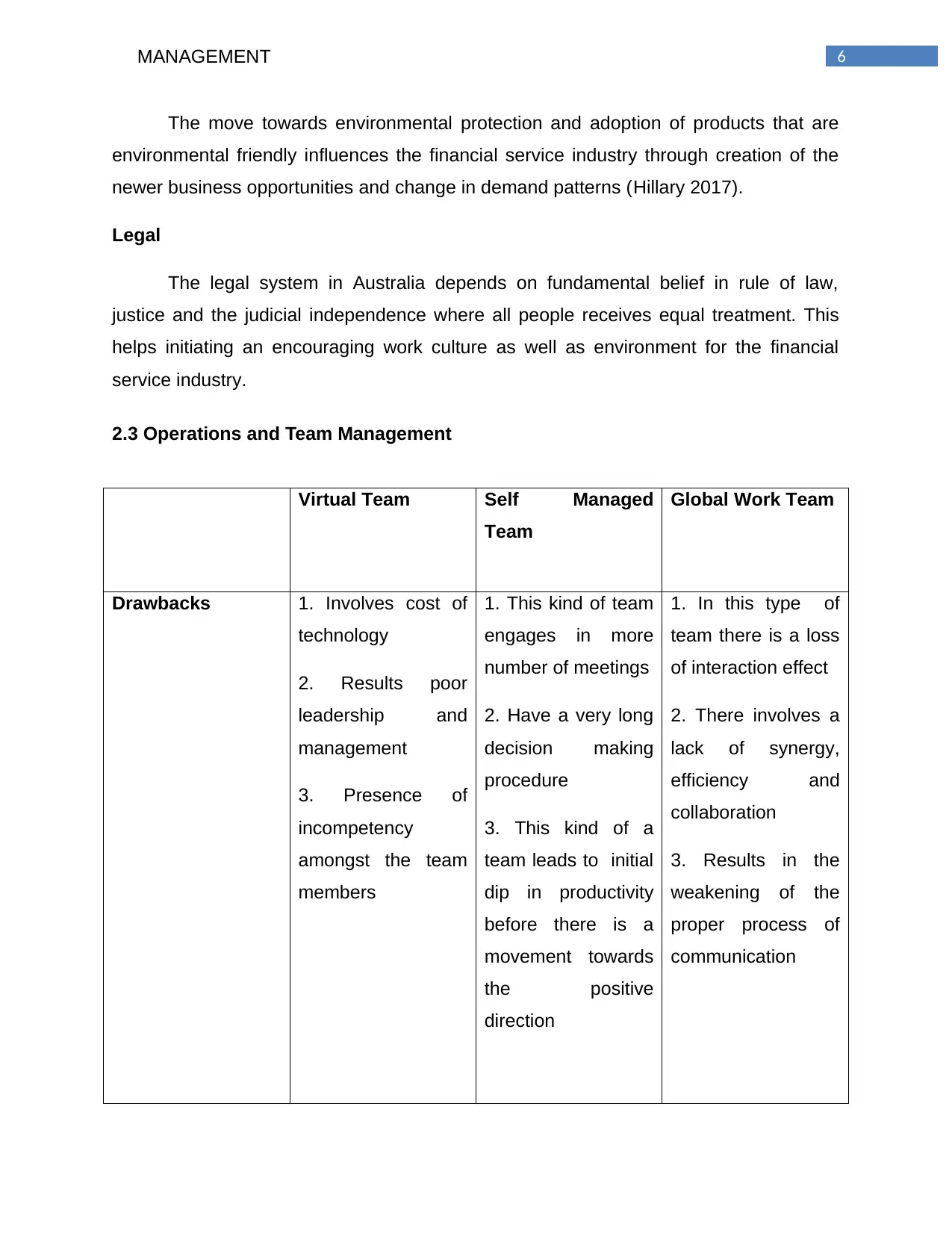
6MANAGEMENT
The move towards environmental protection and adoption of products that are
environmental friendly influences the financial service industry through creation of the
newer business opportunities and change in demand patterns (Hillary 2017).
Legal
The legal system in Australia depends on fundamental belief in rule of law,
justice and the judicial independence where all people receives equal treatment. This
helps initiating an encouraging work culture as well as environment for the financial
service industry.
2.3 Operations and Team Management
Virtual Team Self Managed
Team
Global Work Team
Drawbacks 1. Involves cost of
technology
2. Results poor
leadership and
management
3. Presence of
incompetency
amongst the team
members
1. This kind of team
engages in more
number of meetings
2. Have a very long
decision making
procedure
3. This kind of a
team leads to initial
dip in productivity
before there is a
movement towards
the positive
direction
1. In this type of
team there is a loss
of interaction effect
2. There involves a
lack of synergy,
efficiency and
collaboration
3. Results in the
weakening of the
proper process of
communication
The move towards environmental protection and adoption of products that are
environmental friendly influences the financial service industry through creation of the
newer business opportunities and change in demand patterns (Hillary 2017).
Legal
The legal system in Australia depends on fundamental belief in rule of law,
justice and the judicial independence where all people receives equal treatment. This
helps initiating an encouraging work culture as well as environment for the financial
service industry.
2.3 Operations and Team Management
Virtual Team Self Managed
Team
Global Work Team
Drawbacks 1. Involves cost of
technology
2. Results poor
leadership and
management
3. Presence of
incompetency
amongst the team
members
1. This kind of team
engages in more
number of meetings
2. Have a very long
decision making
procedure
3. This kind of a
team leads to initial
dip in productivity
before there is a
movement towards
the positive
direction
1. In this type of
team there is a loss
of interaction effect
2. There involves a
lack of synergy,
efficiency and
collaboration
3. Results in the
weakening of the
proper process of
communication
Paraphrase This Document
Need a fresh take? Get an instant paraphrase of this document with our AI Paraphraser
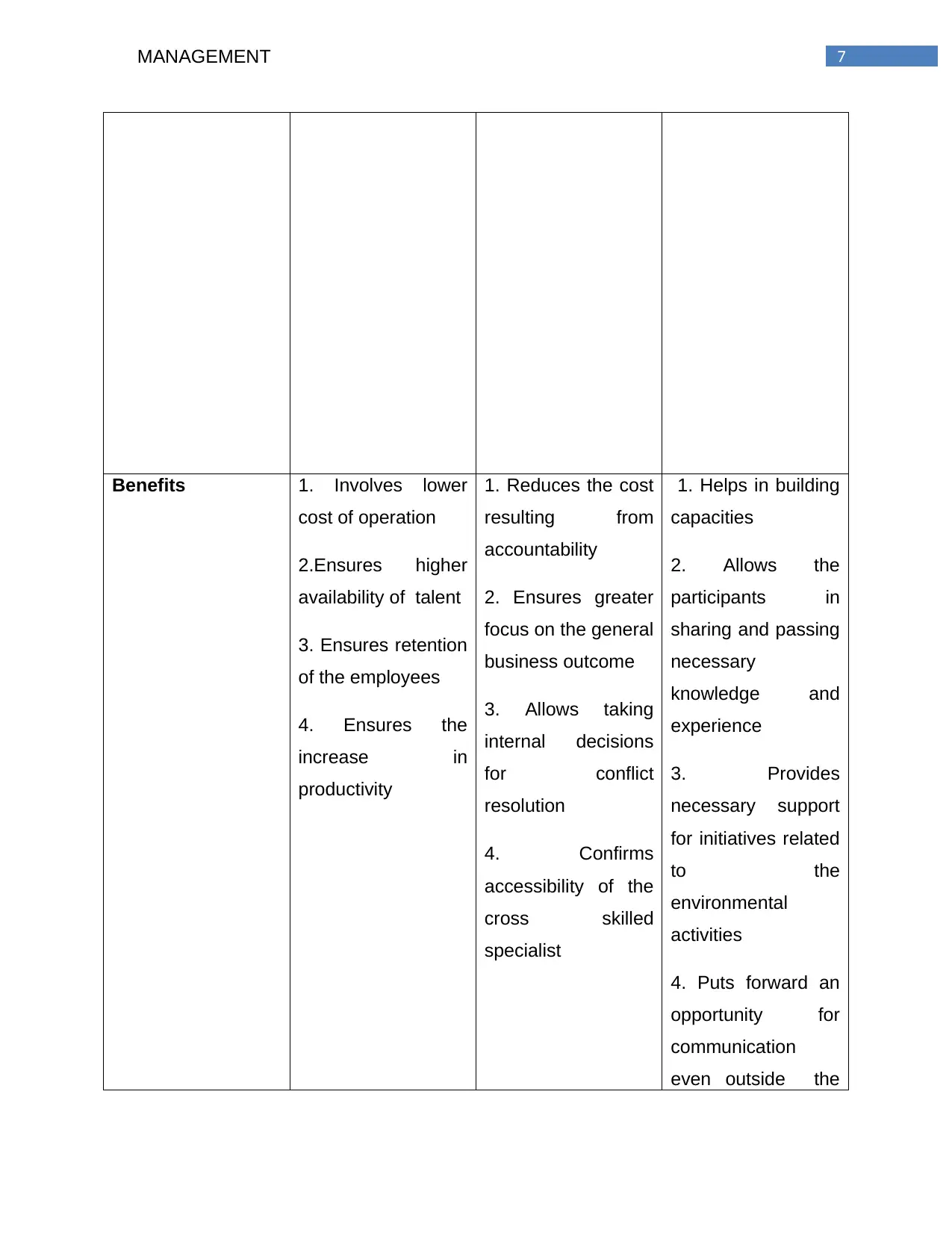
7MANAGEMENT
Benefits 1. Involves lower
cost of operation
2.Ensures higher
availability of talent
3. Ensures retention
of the employees
4. Ensures the
increase in
productivity
1. Reduces the cost
resulting from
accountability
2. Ensures greater
focus on the general
business outcome
3. Allows taking
internal decisions
for conflict
resolution
4. Confirms
accessibility of the
cross skilled
specialist
1. Helps in building
capacities
2. Allows the
participants in
sharing and passing
necessary
knowledge and
experience
3. Provides
necessary support
for initiatives related
to the
environmental
activities
4. Puts forward an
opportunity for
communication
even outside the
Benefits 1. Involves lower
cost of operation
2.Ensures higher
availability of talent
3. Ensures retention
of the employees
4. Ensures the
increase in
productivity
1. Reduces the cost
resulting from
accountability
2. Ensures greater
focus on the general
business outcome
3. Allows taking
internal decisions
for conflict
resolution
4. Confirms
accessibility of the
cross skilled
specialist
1. Helps in building
capacities
2. Allows the
participants in
sharing and passing
necessary
knowledge and
experience
3. Provides
necessary support
for initiatives related
to the
environmental
activities
4. Puts forward an
opportunity for
communication
even outside the
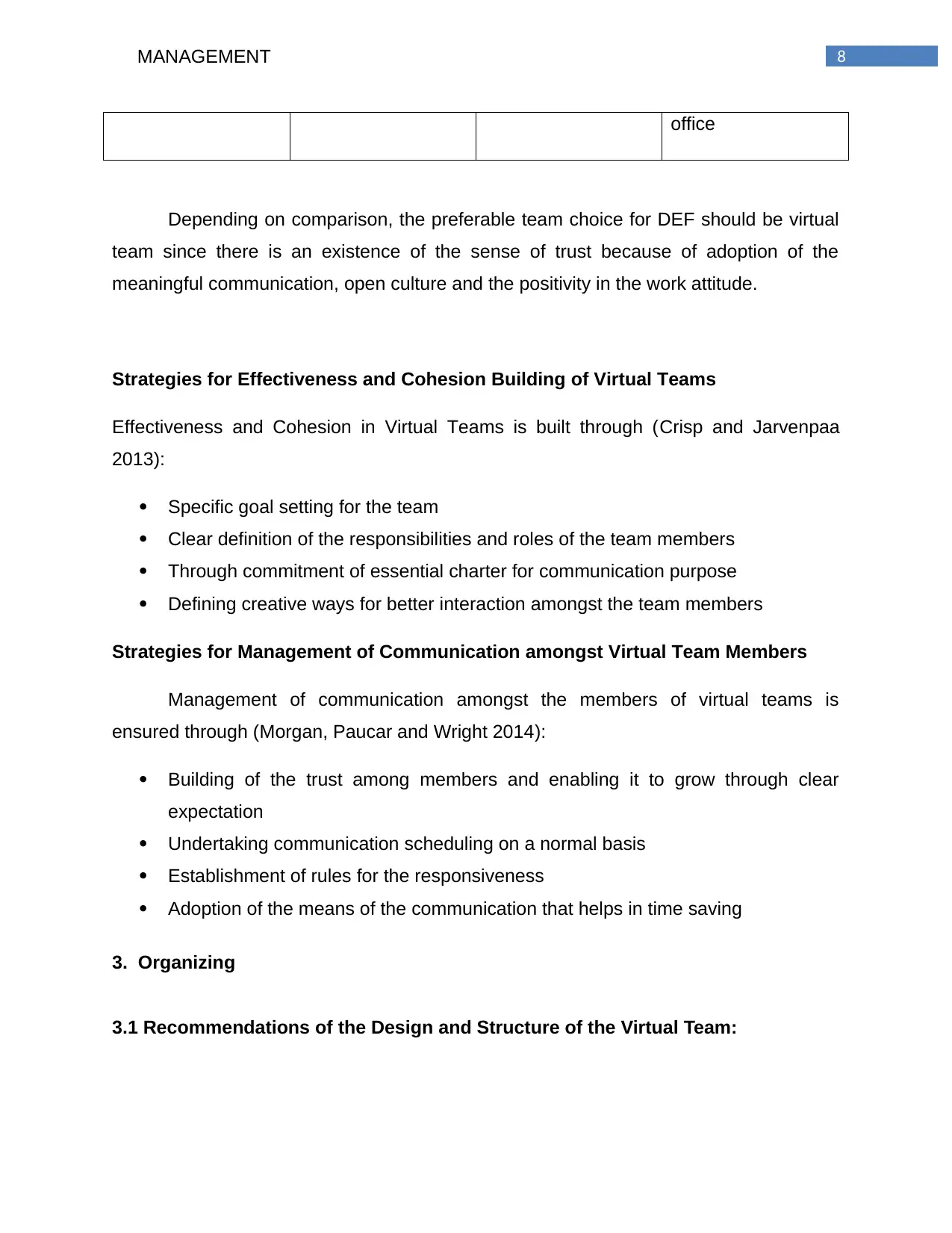
8MANAGEMENT
office
Depending on comparison, the preferable team choice for DEF should be virtual
team since there is an existence of the sense of trust because of adoption of the
meaningful communication, open culture and the positivity in the work attitude.
Strategies for Effectiveness and Cohesion Building of Virtual Teams
Effectiveness and Cohesion in Virtual Teams is built through (Crisp and Jarvenpaa
2013):
Specific goal setting for the team
Clear definition of the responsibilities and roles of the team members
Through commitment of essential charter for communication purpose
Defining creative ways for better interaction amongst the team members
Strategies for Management of Communication amongst Virtual Team Members
Management of communication amongst the members of virtual teams is
ensured through (Morgan, Paucar and Wright 2014):
Building of the trust among members and enabling it to grow through clear
expectation
Undertaking communication scheduling on a normal basis
Establishment of rules for the responsiveness
Adoption of the means of the communication that helps in time saving
3. Organizing
3.1 Recommendations of the Design and Structure of the Virtual Team:
office
Depending on comparison, the preferable team choice for DEF should be virtual
team since there is an existence of the sense of trust because of adoption of the
meaningful communication, open culture and the positivity in the work attitude.
Strategies for Effectiveness and Cohesion Building of Virtual Teams
Effectiveness and Cohesion in Virtual Teams is built through (Crisp and Jarvenpaa
2013):
Specific goal setting for the team
Clear definition of the responsibilities and roles of the team members
Through commitment of essential charter for communication purpose
Defining creative ways for better interaction amongst the team members
Strategies for Management of Communication amongst Virtual Team Members
Management of communication amongst the members of virtual teams is
ensured through (Morgan, Paucar and Wright 2014):
Building of the trust among members and enabling it to grow through clear
expectation
Undertaking communication scheduling on a normal basis
Establishment of rules for the responsiveness
Adoption of the means of the communication that helps in time saving
3. Organizing
3.1 Recommendations of the Design and Structure of the Virtual Team:
⊘ This is a preview!⊘
Do you want full access?
Subscribe today to unlock all pages.

Trusted by 1+ million students worldwide

9MANAGEMENT
Specialization:
Virtual team characterizes a group of individuals who works on the
geographically distributed as well as interdependent task and conducts core work with
the help of an electronic medium (Schiller et al. 2014). Therefore, through hiring of a
specialist the virtual team will be motivated towards certainty. While a generalist will
struggle on the things that necessitates a different means of thinking
Centralization:
Virtual teams represent groups of either organizationally or geographically
dispersed coworkers assembled through the combination of the information and the
telecommunications technology for the accomplishment of an organizational task
(Watanuki and Moraes 2016). In other words, the members of the virtual team makes
use of varying degrees of technologies for working across the temporal, locational and
international boundary for the accomplishment of interdependent task. Such teams are
becoming very much part of the organization. They therefore undertake decision making
by adopting the process of computer mediated communication (CMC).
Formalization:
The procedures and the processes of a virtual team is designed in a manner so
that it does not constrain creativity and innovation as the capability of balancing
flexibility and discipline holds critical importance for project environment (Al et al. 2013).
The administrative structure of project should comprise of enough discipline for
completion of project with minimum bureaucratic interference. The team should also
consider the technical challenges, the government regulations influencing the project, its
complexity and the requirement of the stakeholders of the project. The team should
therefore make us of information in determining the procedural flexibility for completion
of the project. The stability between the bureaucracy and flexibility should be done in a
manner so that it does not become a hindrance in the completion of the assigned task.
Structure:
Specialization:
Virtual team characterizes a group of individuals who works on the
geographically distributed as well as interdependent task and conducts core work with
the help of an electronic medium (Schiller et al. 2014). Therefore, through hiring of a
specialist the virtual team will be motivated towards certainty. While a generalist will
struggle on the things that necessitates a different means of thinking
Centralization:
Virtual teams represent groups of either organizationally or geographically
dispersed coworkers assembled through the combination of the information and the
telecommunications technology for the accomplishment of an organizational task
(Watanuki and Moraes 2016). In other words, the members of the virtual team makes
use of varying degrees of technologies for working across the temporal, locational and
international boundary for the accomplishment of interdependent task. Such teams are
becoming very much part of the organization. They therefore undertake decision making
by adopting the process of computer mediated communication (CMC).
Formalization:
The procedures and the processes of a virtual team is designed in a manner so
that it does not constrain creativity and innovation as the capability of balancing
flexibility and discipline holds critical importance for project environment (Al et al. 2013).
The administrative structure of project should comprise of enough discipline for
completion of project with minimum bureaucratic interference. The team should also
consider the technical challenges, the government regulations influencing the project, its
complexity and the requirement of the stakeholders of the project. The team should
therefore make us of information in determining the procedural flexibility for completion
of the project. The stability between the bureaucracy and flexibility should be done in a
manner so that it does not become a hindrance in the completion of the assigned task.
Structure:
Paraphrase This Document
Need a fresh take? Get an instant paraphrase of this document with our AI Paraphraser

10MANAGEMENT
For the successful operation of a virtual team in the new division there should be
implementation of agenda, preparation of visuals, plan for interaction and a building
time for nurturing of relationships (Pangil and Moi 2014). In addition, team roles should
be identified along with the development of the ground rules involving transparency,
respect, candor, trust and confidentiality. Moreover being present on an ongoing call
considered a good practice. The newer division of DEF is organic. This is because
organic represents a flexible structure that can well adapt to the occurrence of change.
Hierarchy of Managers/ Supervisors:
Supervisors or the managers of a virtual team plays a key role in maintaining the
togetherness of the team but also ensures motivation of its members (Hoch and
Kozlowski 2014). Thus, managers of virtual team are able to effectively manage the
expectations through proper understanding of the requirements of team members.
4. Leading
4.1 Recommendation of the Leadership Style
The leadership style that would best suit the virtual team is the transformational
leadership (Purvanova and Bono 2009). This is defined as leadership approach that
brings about change in the social systems and the individuals. Thus, it is an ideal form
of leadership that not only ensures bringing about a positive change but also helps in
creation of value amongst the followers with the ultimate goal of reflection of their
actions for ensuring personal growth. The leadership style thus helps in motivating the
individual team members thereby leading to the generation of a positive effect on the
effectiveness of the team. In other words, transformational leadership portrays a higher
degree of concern, power and integrity of the team members. Under this form of
leadership style, team members are able to have a clear and compelling vision. These
For the successful operation of a virtual team in the new division there should be
implementation of agenda, preparation of visuals, plan for interaction and a building
time for nurturing of relationships (Pangil and Moi 2014). In addition, team roles should
be identified along with the development of the ground rules involving transparency,
respect, candor, trust and confidentiality. Moreover being present on an ongoing call
considered a good practice. The newer division of DEF is organic. This is because
organic represents a flexible structure that can well adapt to the occurrence of change.
Hierarchy of Managers/ Supervisors:
Supervisors or the managers of a virtual team plays a key role in maintaining the
togetherness of the team but also ensures motivation of its members (Hoch and
Kozlowski 2014). Thus, managers of virtual team are able to effectively manage the
expectations through proper understanding of the requirements of team members.
4. Leading
4.1 Recommendation of the Leadership Style
The leadership style that would best suit the virtual team is the transformational
leadership (Purvanova and Bono 2009). This is defined as leadership approach that
brings about change in the social systems and the individuals. Thus, it is an ideal form
of leadership that not only ensures bringing about a positive change but also helps in
creation of value amongst the followers with the ultimate goal of reflection of their
actions for ensuring personal growth. The leadership style thus helps in motivating the
individual team members thereby leading to the generation of a positive effect on the
effectiveness of the team. In other words, transformational leadership portrays a higher
degree of concern, power and integrity of the team members. Under this form of
leadership style, team members are able to have a clear and compelling vision. These
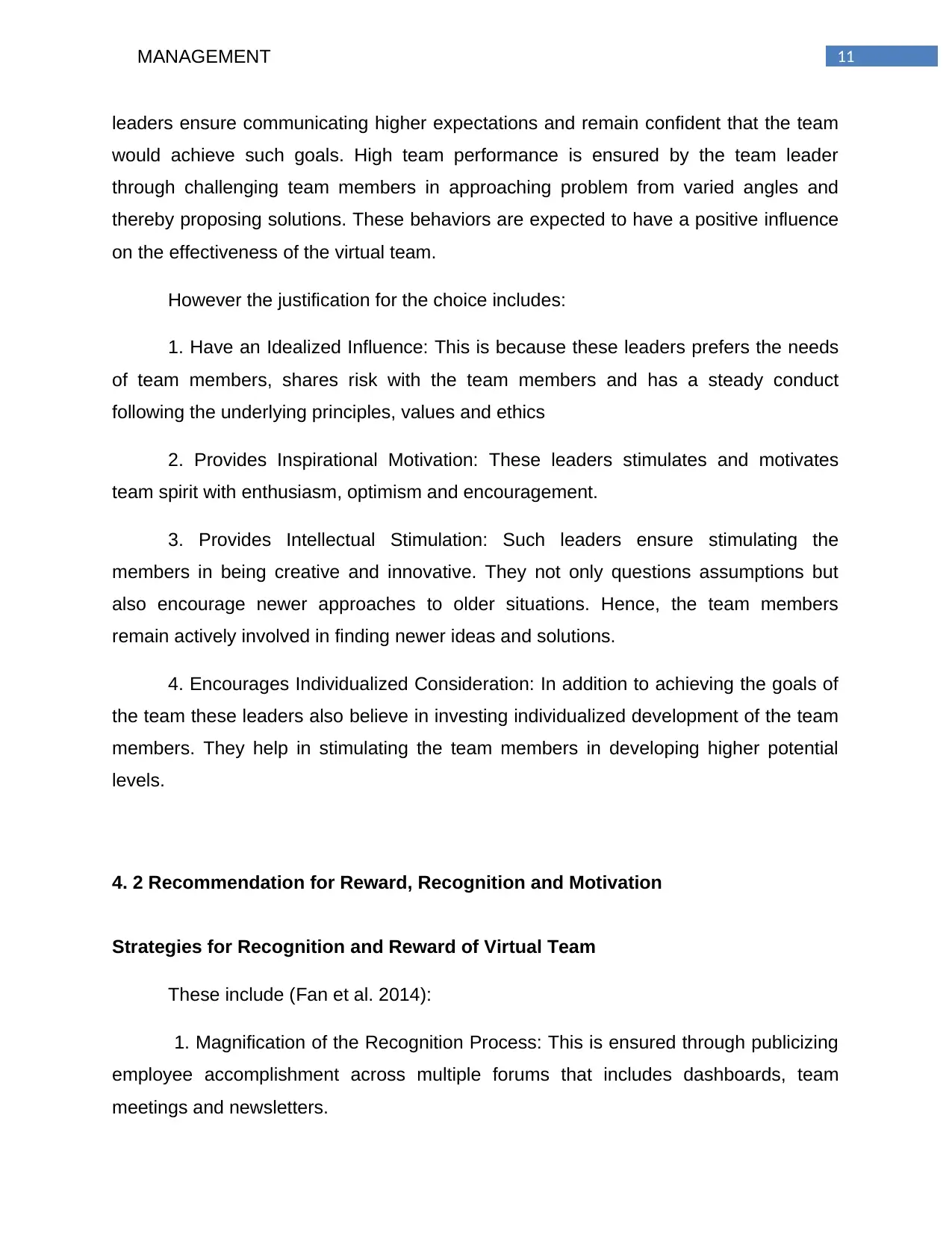
11MANAGEMENT
leaders ensure communicating higher expectations and remain confident that the team
would achieve such goals. High team performance is ensured by the team leader
through challenging team members in approaching problem from varied angles and
thereby proposing solutions. These behaviors are expected to have a positive influence
on the effectiveness of the virtual team.
However the justification for the choice includes:
1. Have an Idealized Influence: This is because these leaders prefers the needs
of team members, shares risk with the team members and has a steady conduct
following the underlying principles, values and ethics
2. Provides Inspirational Motivation: These leaders stimulates and motivates
team spirit with enthusiasm, optimism and encouragement.
3. Provides Intellectual Stimulation: Such leaders ensure stimulating the
members in being creative and innovative. They not only questions assumptions but
also encourage newer approaches to older situations. Hence, the team members
remain actively involved in finding newer ideas and solutions.
4. Encourages Individualized Consideration: In addition to achieving the goals of
the team these leaders also believe in investing individualized development of the team
members. They help in stimulating the team members in developing higher potential
levels.
4. 2 Recommendation for Reward, Recognition and Motivation
Strategies for Recognition and Reward of Virtual Team
These include (Fan et al. 2014):
1. Magnification of the Recognition Process: This is ensured through publicizing
employee accomplishment across multiple forums that includes dashboards, team
meetings and newsletters.
leaders ensure communicating higher expectations and remain confident that the team
would achieve such goals. High team performance is ensured by the team leader
through challenging team members in approaching problem from varied angles and
thereby proposing solutions. These behaviors are expected to have a positive influence
on the effectiveness of the virtual team.
However the justification for the choice includes:
1. Have an Idealized Influence: This is because these leaders prefers the needs
of team members, shares risk with the team members and has a steady conduct
following the underlying principles, values and ethics
2. Provides Inspirational Motivation: These leaders stimulates and motivates
team spirit with enthusiasm, optimism and encouragement.
3. Provides Intellectual Stimulation: Such leaders ensure stimulating the
members in being creative and innovative. They not only questions assumptions but
also encourage newer approaches to older situations. Hence, the team members
remain actively involved in finding newer ideas and solutions.
4. Encourages Individualized Consideration: In addition to achieving the goals of
the team these leaders also believe in investing individualized development of the team
members. They help in stimulating the team members in developing higher potential
levels.
4. 2 Recommendation for Reward, Recognition and Motivation
Strategies for Recognition and Reward of Virtual Team
These include (Fan et al. 2014):
1. Magnification of the Recognition Process: This is ensured through publicizing
employee accomplishment across multiple forums that includes dashboards, team
meetings and newsletters.
⊘ This is a preview!⊘
Do you want full access?
Subscribe today to unlock all pages.

Trusted by 1+ million students worldwide
1 out of 18
Related Documents
Your All-in-One AI-Powered Toolkit for Academic Success.
+13062052269
info@desklib.com
Available 24*7 on WhatsApp / Email
![[object Object]](/_next/static/media/star-bottom.7253800d.svg)
Unlock your academic potential
Copyright © 2020–2025 A2Z Services. All Rights Reserved. Developed and managed by ZUCOL.





